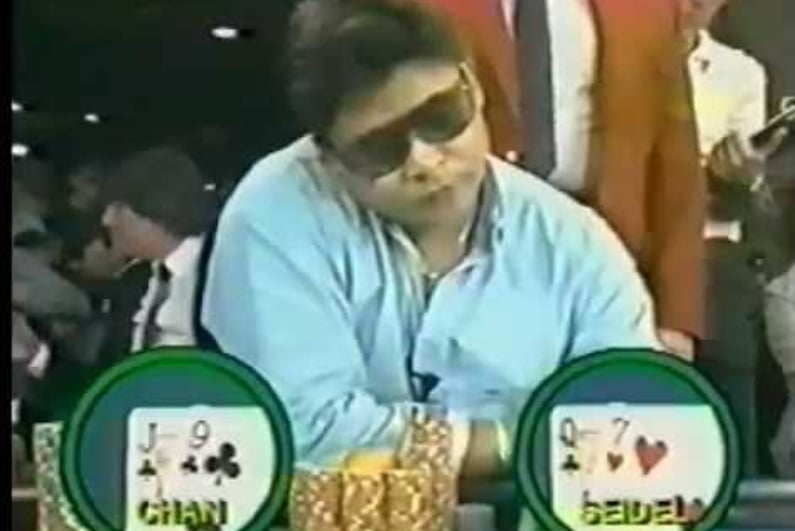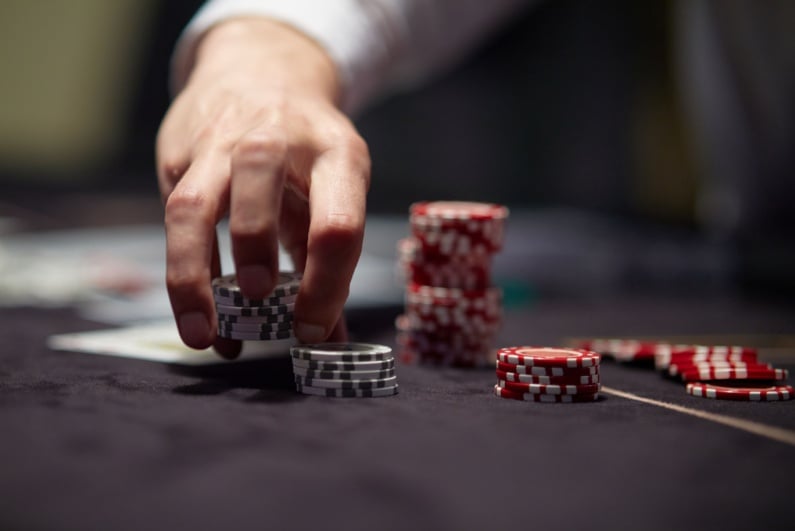Isn’t it iconic, don’t you think?
Depicting a victorious athlete in a conventional style. Displaying the symbolic qualities of a thing so well that you become synonymous with that thing. A poker hand so epic that it transcends the game, reifying something abstract about the nature of competition and risk. Iconic is a difficult word to define.
moments that eclipsed, epitomized, and romanticized the game itself
Starting with Jamie Gold vs Paul Wasicka last week, I am examining five of the most iconic World Series of Poker Main Event poker hands for the next four weeks. They are five moments that eclipsed, epitomized, and romanticized the game itself. They are both familiar and strange, both canny in the old sense and uncanny in the modern sense, in the way that myths and legends are.
Although these hands are part of poker’s collective consciousness, there is something foreign about them too as they are from a different time and place. It is my hope that by demystifying them, new life is breathed into them and perhaps a new appreciation of their iconic status will emerge.
The Orient Express vs The Rookie
With that nauseatingly earnest preamble finally over, the hand I want to look at this week is arguably one of the most famous hands ever played. Immortalized in the movie ‘Rounders,’ it is the final hand of the 1988 WSOP Main Event, played between Johnny ‘The Orient Express’ Chan and Erik Seidel, a man who these days is a bonafide poker legend but, unbelievably, was then playing his first ever tournament.
Chan had won the Main Event the previous year, defeating Frank Henderson heads-up on a final table that also featured Howard Lederer and Dan Harrington. He was riding high and fancied to go back-to-back from the beginning of the final day. Seidel was the rookie, playing for just 30% of himself but he had battled his way to the final table largely under the radar. Big names like TJ Cloutier and Humberto Brenes were also in the mix but they fell in fifth and fourth places, respectively.
he was completely lost at sea when he got to heads-up
If Seidel was in uncharted waters on the final table, he was completely lost at sea when he got to heads-up. When Ron Graham bust in third, Seidel was already flagging and finding it difficult to maintain focus. He also felt out-gunned by the wily Chan who had more chips and a bigger arsenal of weapons when it came to a mano a mano conflict.
The hand
Chan and Seidel had $280,000 locked up but the winner would receive $700,000, so this was a $420,000 heads-up contest (they really had steep payout structures in those days).
Preflop | At the start of the hand, Chan had 1.375 million chips and Seidel had 295,000. The blinds were 10,000/20,000 with no ante. Chan limped the button with J♣️9♣️. Seidel checked his option with Q♣️7❤. |
Flop | With a pot of 40,000, it came Q♠️T♥️8♦️. Seidel checked, Chan bet 40,000, Seidel raised to 90,000 and Chan called. |
Turn | The pot was 220K and it came the 2♠️ so the board read Q♠️T♥️8♦️2♠️. The action went check, check. |
River | To the river, the pot was still 220K and it came the 6♦️ so the final board was Q♠️T♥️8♦️2♠️6♦️. Seidel shoved his remaining 185,000 chips and with the nuts, Chan has the easiest call ever to win the Main Event for a consecutive year. |
Analyzing the pre-flop and flop
The first thing to consider is just how shallow the effective stack was in this hand. Seidel has less than 15 big blinds. The second relevant detail is there is no ante. Chan’s limp with a suited one-gapper is definitely the standard line. With a big blind ante (as would be more usual today), he could definitely consider shoving but with a higher risk to reward, I like his decision to just call. Seidel’s knuckle back is also perfectly fine.
On the flop, Seidel’s check is tidy and Chan has a definite bet. His pot-sizing is more than I would choose but interestingly a solver would advocate a mix of bet sizes, including full pot. With the straight, Chan unblocks the pairs/two-pair hands so Seidel will have a lot of hands that will call at least once.
all he is really doing is bloating the pot unnecessarily out of position
Seidel’s flop raise achieves very little. I suppose for that sizing he can get called by worse but all he is really doing is bloating the pot unnecessarily out of position. I’m inclined to file this under ‘old-school information bet’ and there’s a reason that they fell out of favor.
Chan’s spot is dreamy – he has the nuts and his opponent is raising into him. 3-betting is an option as there are scare cards that could kill his action but I think flatting, as he did, is the superior choice. There is only one more bet in the hand and it is likely that Seidel, having now become the aggressor, will make it himself on the turn.
Analyzing the turn and river
The deuce on the turn is a total brick and Seidel has created a messy spot for himself. On the one hand, Chan could be drawing and you definitely want to deny equity against those hands. However, by raising Chan’s pot-size bet you have strengthened his range to contain a large amount that beat you. On balance, I like his decision to check.
After Seidel checks, Chan has an interesting spot. Should he massage the pot with a one-third pot bet or should he check and set the trap? It feels close and a solver would do both at some frequency but I like the check.
Chan’s turn check did certainly embolden Seidel, making him think he had the best hand and was up against perhaps a hand like K-10, J-10, 10-9, or 8-9. Versus those hands, he did not want to get reverse-freerolled so he elected to bet himself.
Given the size of the pot, it’s difficult to find a bet-size that isn’t all-in but perhaps he could have wagered 75,000. I prefer this bet for a couple of reasons:
- This size is more likely to get called by a hand like Q-4, J-10, or 9-10 which should be our target hands.
- This size leaves room for Chan to bluff. By going all-in, you are limiting Chan to responses only with the value portion of his range.
Inevitable
Overall, Chan gets a lot of credit for setting the trap in this hand but, in reality, there was a certain inevitability to Seidel going broke, or at least losing the majority of his stack once that cooler flop was dealt. Seidel should not have raised the flop and instead just called. Had he taken that action, he could perhaps have found an escape route on turn or river depending on sizings, although theoretically, he would have to call it off on this particular run-out.
I was thrown into that experience having never even seen the final table.”
Heads-up poker is such a specialty format and Chan would have had a decent amount of experience versus the then-recreational Seidel. “I was really, really tired and it was very hard for me to be as focused as I should have been at the time,” said Seidel in an interview years later. “I was thrown into that experience having never even seen the final table.”
The very next year, Chan would be denied a mind-blowing Main Event three-peat by an upstart ‘Poker Brat’ from Madison, Wisconsin. ‘The Orient Express’ would remain a force in poker for two more decades, winning his last bracelet in 2005.
Meanwhile, Seidel’s rise in the game stutter-started but was precipitous between 1992 and 2007, a period in which he won eight WSOP bracelets and at one time was the winningest tournament poker player in history. He has remained a dominant force, respected by the modern wizards as an old-schooler who still punches with the best. He won his ninth WSOP bracelet in 2021 in the $10,000 High Roller Event for $978,000.
Both Chan (2002) and Seidel (2010) have been inducted into the Poker Hall of Fame.




